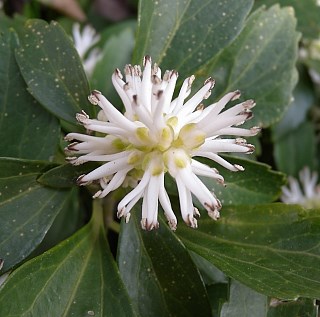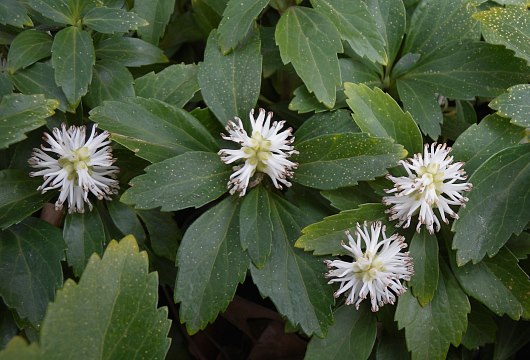Description:
This
plant is an evergreen perennial about 4-10" high that creeps along the
ground, forming a dense ground cover. Individual stems are up to 12"
long, light green, glabrous, and unbranched; they are erect toward
their tips. Alternate leaves are spaced closely together toward the
tips of the stems, forming pseudo-whorls. The leaf blades are 1-3" long
and 1/3-1" across; they are oblanceolate in shape, dentate along the
outer half of their margins, and rather stiff and leathery in texture.
Each blade tapers gradually into a short petiole. The upper surface of
the leaf blades is dark green and glabrous. Some stems terminate in
solitary spikes of flowers about ¾–1½" long on short stalks. Japanese
Pachysandra is monoecious. The typical floral spike has 15-25 staminate
(male) flowers along its
central and upper portions, and 1-2 pistillate (female) flowers at its
bottom. The rachis (central stalk) of the floral spike is light green
and glabrous. Individual staminate flowers are about 1/3" (8 mm.) long,
consisting of 4 appressed tepals and 4 prominent stamens. The tepals
are light yellowish green, glabrous, and oval-ovate in shape; they are
about 1/8" (3 mm.) long. The thick filaments of the stamens are bright
white
and long-exerted. Individual pistillate flowers consist of 4-6 tepals
and a pistil with a pair of styles. The blooming period occurs during
the spring for about 1 month. The flowers have a sweet fragrance.
Sometimes immature flowering spikes are produced during the fall, but
they rarely bloom. Fertile female flowers produce small white berries
about 1/3" (8 mm.) across; however, such berries are rarely produced.
The root
system is rhizomatous, readily forming dense colonies of plants.
texture.
Each blade tapers gradually into a short petiole. The upper surface of
the leaf blades is dark green and glabrous. Some stems terminate in
solitary spikes of flowers about ¾–1½" long on short stalks. Japanese
Pachysandra is monoecious. The typical floral spike has 15-25 staminate
(male) flowers along its
central and upper portions, and 1-2 pistillate (female) flowers at its
bottom. The rachis (central stalk) of the floral spike is light green
and glabrous. Individual staminate flowers are about 1/3" (8 mm.) long,
consisting of 4 appressed tepals and 4 prominent stamens. The tepals
are light yellowish green, glabrous, and oval-ovate in shape; they are
about 1/8" (3 mm.) long. The thick filaments of the stamens are bright
white
and long-exerted. Individual pistillate flowers consist of 4-6 tepals
and a pistil with a pair of styles. The blooming period occurs during
the spring for about 1 month. The flowers have a sweet fragrance.
Sometimes immature flowering spikes are produced during the fall, but
they rarely bloom. Fertile female flowers produce small white berries
about 1/3" (8 mm.) across; however, such berries are rarely produced.
The root
system is rhizomatous, readily forming dense colonies of plants.
Cultivation:
The preference is light shade, moist conditions, and rich loamy soil
with organic matter. This plant can spread aggressively and it is
difficult to remove. Excessive sunlight can cause the leaves to turn
yellowish green.
Range & Habitat:
While it is often cultivated, Japanese Pachysandra rarely escapes. So
far, it has naturalized in DuPage County (see Distribution
Map). It is possible that this plant may become more common
in the future, particularly around urban areas. This plant was
introduced into North America from China and Japan as an ornamental
plant for gardens. Habitats in natural
areas include deciduous woodlands and woodland edges.
Faunal Associations:
Very little is known about floral-faunal relationships for this plant.
Bees are attracted to the flowers during the spring, where they collect
pollen; nectar is not produced. The foliage is toxic to mammalian
herbivores and is rarely consumed; it contains cytotoxic alkaloids. The
rarely produced berries are probably eaten by birds or small rodents,
thereby distributing the seeds to new locations.

Photographic
Location:
Underneath a tree at the Independent Media Center in Urbana, Illinois.
Comments:
Because of its attractive evergreen foliage, Japanese Pachysandra is
cultivated primarily as a ground cover in shaded areas along buildings
and underneath trees. The odd-looking flowers are also attractive,
particularly when they are viewed close-up. There is a less well-known
species, Pachysandra procumbens (Allegheny
Pachysandra), that is native to wooded mountainous areas of eastern
United States. So far, it has been found in southern Indiana, but not
Illinois. Allegheny Pachysandra differs from Japanese Pachysandra in
the following characteristics: 1) it has wider leaf blades that taper
abruptly into petioles, and 2) it produces axillary flowering spikes
from below, rather than terminal flowering spikes at the tips of stems.
Sometimes these species in the Pachysandra genus are referred to as
'Japanese Spurge' and 'Allegheny Spurge.'